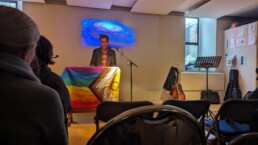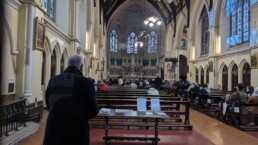Out with God: Serving the Queer Faithful in Ireland
BLACKROCK, Ireland — On a cold, damp March afternoon, a bright orange door sat open, welcoming passers-by to the Methodist church in suburban Dublin.
But Urban Junction, as the building is called, wasn’t being used for a Methodist service. A handful of people were filtering into the church, located at 42 Main St., Blackrock, County Dublin.
Inside and down a flight of stairs, roughly a dozen people had gathered around a lectern with a pride flag, a rainbow complete with intersectional black and brown stripes, trans colors and the distinctive purple circle over a yellow field marking intersex identity. It was the March meeting of Amach le Dia, an LGBTQ+ affirming Christian worship service.
Amach le Dia, Irish for “out with God,” bills itself as the only active queer-affirming Christian worship group in the Republic of Ireland. In a country that was once deeply religious but has seen a rapid decline in church attendance that has coincided with a fast-paced liberalization of society, Amach le Dia serves as something of a sanctuary for a small but devout cluster of queer Christians and their families.
Meeting in a well-lit church basement about the size of a tennis court, Amach le Dia’s worship space recalled the humble simplicity of Protestant worship services. In the corner, a bearded man with long, brown hair and an acoustic guitar tuned his instrument.
Despite appearances, organizers said this was not a service restricted to any one faith or denomination — anyone was welcome, Protestant, Catholic, non-Christian, atheist, agnostic or curious.
Bustling about the basement, Alison Finch, a 46-year-old veterinary nurse with short hair and a kind smile, was overseeing the preparations. Seeming to recognize most people who entered, she offered tea and coffee with determination.
“Our aim really is to provide a space for Christians who are, you know, LGBT and maybe feel they don’t have anywhere they can be open and worship,” she said.
Finch, who is gay, was a founding member of Amach le Dia in 2019. Born to a Protestant Church of Ireland family, she said she first found queer Christian ministry around 2005.
That’s when she began attending services at Multyfarnham, where a Franciscan friary had begun a service for gay Christians. Then, there was the “All are Welcome” Mass, a Catholic service in Dublin which ran during the 2010s.
With little institutional support, both of these services fizzled out over time. By 2019, Finch realized there was no active worship service left.
“I sort of realized there was nothing going on in Ireland at the minute for LGBT Christians,” she said. “I thought, ‘well, there’s nothing going on. Maybe it’s my turn to, you know, start something.’”
After getting in touch with some of her fellow LGBT Christians, she helped found Amach le Dia by December 2019.
Since then, the group has been hosting monthly meetings and Bible studies, often with guest speakers and songs. Now, she says the organization is meant “to provide a safe space for LGBT people who have felt, you know, they don’t want to go to church.” The space provides her and others like her a place to blend these two parts of their identities.
“Many people believe it's a surprising mix, they believe people would have to choose between the two,” she said. “For me this has never crossed my mind. I have always known God made me the way I am [and] loves me the way He created me.”
In the corner of the room, the man strummed his guitar with feeling and led the congregation in song. Many joined him in the gentle hymns, the lyrics projected on the wall.
Looking around to her fellow worshippers in the basement, Finch wasn’t sure what had brought each of them there. She said that, of course, the organization catered to gay and trans people, and to people from Catholic and Protestant backgrounds, but did not make it her business to know people’s personal history.
“The honest truth is, I don’t know because I never ask,” she said. “I don’t really know what people are. Anybody can come and we don’t ask you when you come in the door, ‘why are you here?’”
Teagan MacAodhagáin, a father, chatted by his family of young children, sprawled on a couch that had been pulled around to make a more comfortable pew than the metal folding chairs that lined the room.
MacAodhagain, who chairs Amach le Dia and holds a master’s degree in theology, frequently leads the group’s services.
“In mainstream churches… you were allowed to do certain things like, move furniture and make tea,” he said. “Depending on the church, maybe Sunday school, maybe some worship, be in the worship band somewhere, and, you know, not everyone is gifted at tea or music.”
As a practicing Methodist, MacAodhagain said Amach le Dia reflected the ideas of his religion more closely than his mainstream Protestant church. Citing John Wesley, the English cleric who founded Methodism, he said the Church was “handicapping itself” by limiting LGBT participation in services.
“Wesley had the same idea,” he said. “His criteria for people belonging to the church is that they all had to use their gifts, and there was no limitations.”
Institutionally, the Methodist Church holds the view that marriage is inherently meaningful only between a man and a woman. “Practicing homosexuals” are barred from ordination, though transgender people are able to be ordained.
The lights dimmed and a projector displayed more soft Christian rock lyrics over a stock image of a galaxy. MacAodhagain made his way to the front of the room. The service started late, which Finch said was typical.
He introduced Jude Lal Fernando, one of his professors from Trinity College’s theology school, as the guest speaker for the service. Fernando spoke on how power and powerlessness feed conflict everywhere from his native Sri Lanka, to Ireland, to Israel and Palestine. The toddlers on the sofa struggled to sit quietly, just like millions of Christian children before them, as the service proceeded in a warm, orange light.
Following the speech, the guitarist struck passionate, saccharine chords, belting out slow tunes of modern worship. Sitting on the basement floor, Finch joined in song with closed eyes.
In the Candlelight: Reflections & Remembrance at a Roman Catholic Church in the Bronx
NEW YORK — An elderly woman stood over an array of mostly unlit candles at St. Barnabas Roman Catholic Church, which is located in a heavily Irish neighborhood on the border between The Bronx and Yonkers. Dusk hung heavy inside the nave as the raw, rainy evening filtered through dark stained glass. Three or four lit candles weakly brightened the dim space, leaving a detailed painting of Jesus peeking through the shadows on the high ceiling.
The woman arched her head downward. Two middle aged men leaned on either side of her, the three bodies close, their puffy winter coats forming one whole. They were silent, but their emotion — unmistakeable grief — cut across the room. After a moment, the trio quickly shuffled into the growing crowd of congregants.
It was Sunday evening at St. Barnabas, located at 409 East 242nd Street. Sturdy and rectangular, the Italianate-style church has beckoned Woodlawn’s Catholics for Sabbath celebrations since 1911. On the Catholic liturgical calendar, it was the Fourth in Ordinary Time and the faithful were quietly taking their places in the church’s long wooden pews. Filling up yet leaving everyone with ample personal space, a few families and many lone elders took their seats. Some dressed casually — tight jeans and a fleece — while others were more proper — a suit and tie under a tan peacoat.
Walking the line between the two styles, a polished 20-something in a shirt with a loose top button and no tie walked past the pews. He brought a narrow binder from the sacristy, a bright white room where the priest and altar servers prepared for the 5 o’clock mass, due to start in about two minutes.
The lights flashed on in dramatic fashion, yellowish LEDs supplanting the wiggling candle glow. The elaborate fresco-style painting above the altar led all eyes to Jesus Christ, heroically pictured at the center, surrounded by the Holy Family, the Apostles and flying cherubs. Around the altar, floral arrangements, green, white and red-orange evoked, perhaps by coincidence, the Irish Republican tricolors flying throughout the neighborhood.
The young man read a few announcements from a binder. He welcomed visitors, proclaimed that St. Patrick’s Day was fast approaching (it was still January), and read out a Wikipedia-style appeal for donations.
“If everyone here today donated…”
After mass, a few more people approached the candles. There were six separate arrays — two at the back, four at the front, including two dated-looking tables of electronic “candles” with push buttons that could light up your plastic tube of choice. The real candles were far more popular; none of the electric candles were turned on.
Names were engraved on the edge of the arrays, recalling the memory of various parishioners. Boxes with small slots hung beneath the candles, instructing how to donate if you wish to light one. One woman dropped a few dollars in the box. She lit two candles and knelt deeply before them, whispering a prayer.
Soon, she rushed off, perhaps bothered by my presence, and I decided to let her be.
Outside, I caught up with the fashionable lector named Terrance Tunnock (“T-U-N-N-O-C-K… Like the tea biscuit”) who told me he reads every week at 5 p.m. He said the candles are for special intentions, hopes, wishes, prayers. Often, people light candles for those they have lost.
As the dusk turned to night, the nave emptied out. Tunnock began tidying up around the church entrance, the priest returned to the sacristy, and the candles burned.
Day Six: In Belfast, a City Still Learning Peace and Healing from the Past
BELFAST – After another traditional Irish breakfast buffet of eggs, beans and black pudding, we departed Londonderry for Belfast. This time, the ride was sleepier, as we watched the countryside roll by and reflected on the trip so far.
Like Londonderry, memories of the conflict were alive in Belfast, with the majority Protestant city, the largest in Northern Ireland, draped in Orange Order flags and Irish tricolors alike.
Our bus arrived early at the Europa Hotel, billed as “the most bombed hotel in Europe.” Driver Ben took us on a quick loop through a nearby Protestant neighborhood, Sandy Row, where we were greeted by murals of the Protestant King William of Orange and Queen Elizabeth II. The pubs in the area flew Israeli flags — a stark difference from what we saw in the predominantly Catholic Derry, where sympathies were heavily pro-Palestine.
As we pulled back around to the Europa, our driver cautioned us not to wear any political memorabilia from Derry while walking around Belfast, lest we offend anyone. He said we’d be able to know if we were in a Protestant or Catholic neighborhood by the art and flags.
“[It is] totally crazy, but that’s just the way things are,” he said.
Charity in ‘No Man’s Land’
After dropping off our bags at the Europa, we set out for Youth Link NI, a peace-building youth organization that is unique in that it officially involved both the Catholic and mainline Protestant church leaders, according to our guide, Dr. Barbara McDade, who once chaired the organization.
The charity’s headquarters sit in a “no man’s land” area of West Belfast, near a Protestant enclave of the predominantly Catholic part of the city. “Peace walls,” like we saw in Londonderry, divide Catholic and Protestant neighborhoods. Here though, some stand over 40 feet high. Although the risk of petrol bombs and missiles was less of a threat than during the Troubles, both McDade and our driver insisted that the barriers provided psychological protection to both communities.
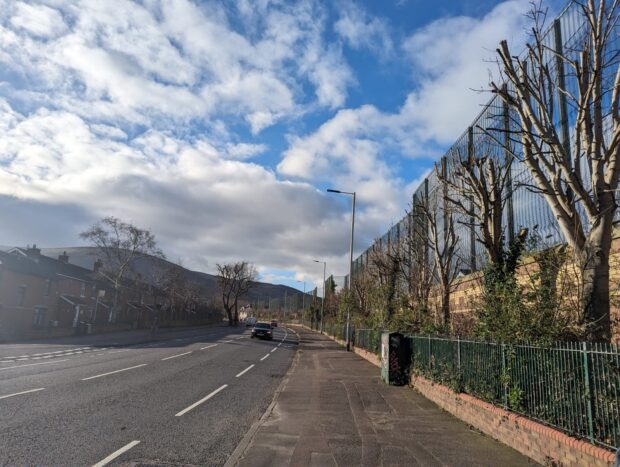
The walls were not the only harsh barriers in the neighborhood. McDade led us on a walk that included a stop outside an Orange Order lodge, blocked off by high fences with spikes that curved outward at the top.
She then led us to a walled-off building, complete with additional high metal barriers, watchtowers and cameras. What looked like a military outpost was simply the local police station in Belfast, McDade explained. On the same road, was a gate that McDade said was manually closed each night to prevent Catholics from crossing into the Protestant neighborhood.
Here, McDade shared with us the history of the Royal Ulster Constabulary, the police force during the Troubles that was 97 percent Protestant. The peace process led to several changes in the police force, now called the Police Service of Northern Ireland (PSNI). Affirmative action increased the number of Catholic officers. Still, Catholic PSNI officers often face violence from dissidents of their own communities, McDade said.
“It’s still considered too dangerous for [PSNI officers] to be on foot,” she said of the neighborhood. “The threat, particularly from dissident republicans, is still quite high.”
We saw a memorial to the Springhill Westrock Massacre across the road, commemorating another tragedy at the hands of the British Army.
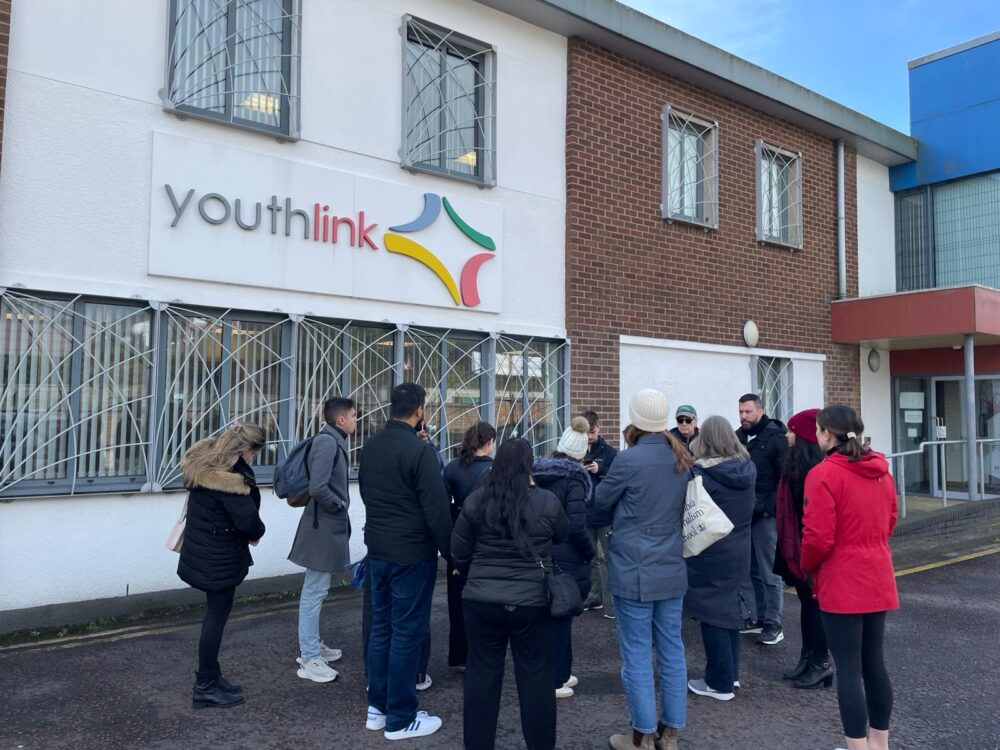
Youth Link makes a point to employ asylum seekers for its catering services — including the lunch of curried chicken, vegetables and rice we shared. We also sipped tea and coffee while mingling with Youth Link employees.
After lunch, we gathered in a circle with Joe McKeown, a Catholic and the director of Youth Link, around an eclectic pile of flags, clothing and religious regalia from Ireland and around the world. A portrait of Queen Elizabeth sat over a Palestinian flag. A Gaelic football jersey was beside a Ulster Volunteer Force banner — an illegal symbol of the Protestant paramilitary in most contexts. And an American flag was right beside a Confederate flag — something that he said once made a group of visiting Americans so uncomfortable, they wouldn’t enter the room.
“These symbols do have power,” said McKeown. A few people winced as he accidentally stepped on the U.S. flag, proving his point.
McKeown told us that his grandfather was killed by a British soldier’s crossfire. Soon after, papers reported that he was an IRA agent. The trauma that impacted his family in the wake of the tragedy had a significant impact on his life. By his teen years, the sight of a British flag would cause him anxiety, he said.
“My body would go into shivers, I would feel threatened,” he said. Since then, he’s been on a “journey of reconciliation.”
He even tried to meet the soldier who’d killed his grandfather. The soldier had been 18 at the time.
“Kids with guns, trained to kill,” he said.
'How Do We Remember?'
Next, an interfaith panel joined us to talk about Ireland’s minority faiths. With representation from the island’s Baha’i, Romanian Orthodox, Muslim and Hindu communities, we discussed how the growing diverse groups fit within the Irish story.
“It’s still being written,” said Adrian Cristea, a Romanian Orthodox leader of the Dublin City Interfaith Forum.
After the panel, McKeown brought us to Clonard Monastery, in a neighborhood with deep Catholic roots. On the way there, we passed another gate that separates the neighborhood and locks from 8 p.m. to 6 a.m. Beside a towering “peace wall” we stopped at a memorial to IRA members and civilians killed in the conflict.
“My mother would not be comfortable with me standing here,” McDade, a Protestant, said.
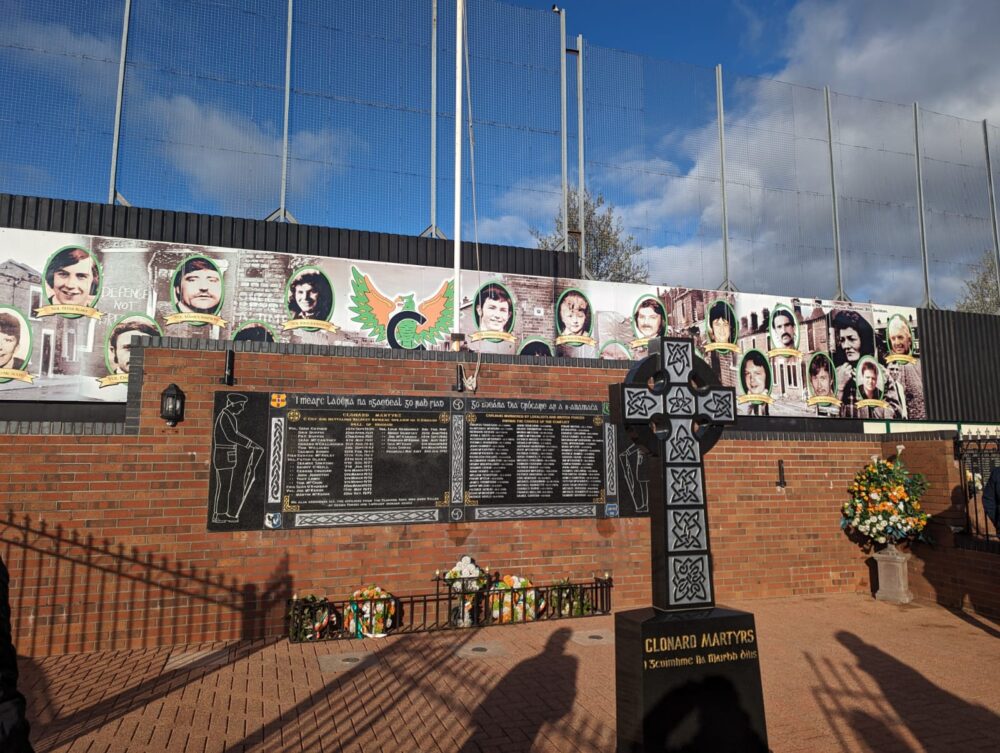
McKeown said there are two difficult questions Belfast residents have to ask themselves: How do we recognize the dead, and how do we also acknowledge that there are victims on the other side of the wall? “How do we remember?”
In the monastery, some students lit a memorial candle for peace, at McKeown’s suggestion.
After a quick dinner on our own, we headed to Belfast Cathedral for a St. Patrick’s Day concert by Anúna, the original musicians behind the ’90s Irish hit Riverdance. Toward the end, the group’s leader, Michael McGlynn, from Dublin, introduced the song Pie Jesu. His version, composed in 1998, commemorates a bombing in Omagh, in the Northern Ireland county of Tyrone. The bombing killed 29 people, months after the Good Friday Agreement was signed on April 10, 1998.
“I don't particularly want to talk about the context,” he said. “Everyone here has a story about the Troubles.”
Edited by Ann W. Schmidt
Unexpected Defeat of Referendums Shows Growing Power of Ireland’s Traditional Catholics
DUBLIN (RNS) — At a Mass said in Latin on Sunday (March 10), Ireland’s traditional Catholics declared political victory, days after a pair of referendums aimed at secularizing the Irish Constitution were unexpectedly and resoundingly defeated.
On Friday, the Irish government put two measures to a vote that would have extended the rights of unmarried couples in the country’s constitution and removed language defining women’s roles “within the home.” Both had been widely expected to pass despite enjoying little debate in the Dail, or Irish parliament, and after a rubber stamp by all three of the Irish Republic’s main political parties.
Both proposals failed, even in progressive Dublin. When all votes were counted, 67.7% of voters had rejected the family amendment, while 73.9% rejected the measure dealing with women’s roles, referred to as the care amendment. Turnout was 44.4%.
On Sunday, as pundits and reporters struggled to explain the most strongly rejected referendum in the republic’s history, roughly 200 traditional Catholics, many in their 30s and 40s, gathered at St. Kevin’s Church, Harrington Street, one of the few places in the city where the traditional, pre-Vatican II Latin Mass is still celebrated, for a triumphant celebration and a redoubt of conservative Catholics.
Even as a much smaller crowd arrived for the noon English-language Mass, those who had attended the 10:30 a.m. Latin Mass — men in tweed jackets and women in long skirts and white, floral head coverings — packed into the tight parish hall for tea, still buzzing with delight at the vote.
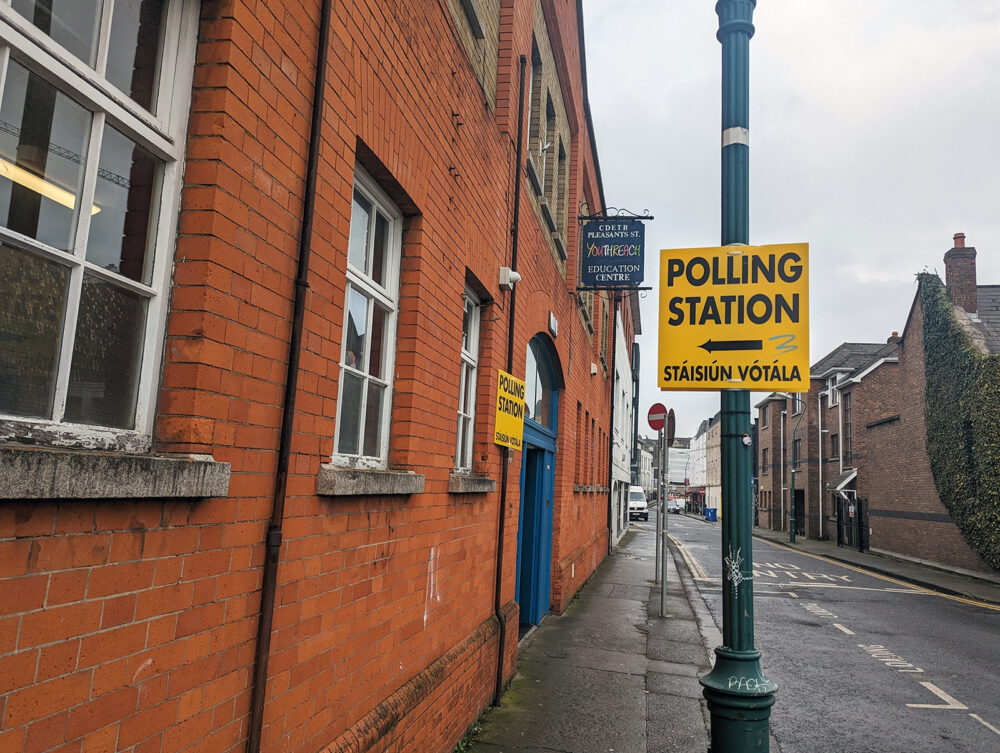
The Latin Mass was largely done away with by the Second Vatican Council, when bishops meeting in Rome from 1962-1965 instituted Masses in local languages. However, some traditional Catholics remain drawn to the old Latin rite that dates to the 1500s.
That rite, which was allowed to be said more widely under Pope Benedict XVI, has become a flashpoint under Pope Francis, who in 2021 barred priests from saying it without permission from their bishops. Traditionalists have seen it as a symbol of the larger battle in the church over matters such as LGBT inclusion and the roles of women.
This divide was on display at the entrance to St. Kevin’s, in copies of Catholic Voice, a traditionalist newspaper whose latest issue looks forward to St. Patrick’s Day on March 17 while urging Irish Catholics to have the “courage” to declare that “liberalism is a sin” and deriding the “myths created by the homosexualist movement.” In a time when the pope is allowing priests to bless people in LGBTQ unions, the paper maintained that those who do not oppose “disordered sexuality” are “straddling Satan’s fence.”
The message that Catholic values are under threat from within the church has hit home in Ireland, where society was overwhelmingly Catholic a generation ago. As of 2022, Catholics made up just 69% of the population, down sharply from 79% in 2016. Weekly Mass attendance among Catholics hovers around one-third nationally, down from over 90% in the 1970s.
Accompanying this transformation have been referendums in which the Irish have legalized divorce (1995), gay marriage (2015) and abortion (2018).
But references to both marriage as a fundamental societal unit and to the roles of women in the home will now stay in the constitution. “It’s a great result for women, for mothers, for the homes and for marriage,” said Maria Steen, a prominent conservative activist. “And I think it’s a real rejection of the government’s attempt to, you know, delete all of that from the constitution.”
Steen ran a brief campaign that framed the removal of motherhood from the constitution as both sexist and anti-Catholic. She said Friday’s election result was a sign that the Irish had “gratitude” for motherhood.

At St. Kevin’s, Michelle McGrath, a conservatively dressed woman in her 40s, said she was unsurprised by the vote result. She attributed it in part to the vagueness of the proposals, which would have equated marriage with other “durable” relationships. “Most people were confused about what it was, really,” said McGrath. “I don’t know what I’m being asked here.”
Confusion about what would be deemed durable relationships seemed to doom the referendum on marriage. In a televised debate on March 5 between Steen and Ireland’s deputy prime minister, or Tanaiste, Micheál Martin, he suggested that the court would decide what constituted durability, which would determine parental rights and inheritances.
McGrath said deeper frustrations were also at play. Steen and the “No” campaign suggested repeatedly that the broadened relationship laws would have facilitated greater immigration into Ireland, which has become increasingly controversial in the once demographically homogenous republic.
“People are starting to find their courage again in Ireland, and the people who’ve been silenced for a very long time are starting to call out the obvious injustices going on,” McGrath said. “The Irish have been put paddy-last, to use the pun, in their own nation. They have been sent to the back of the queue while minorities get the majority.”
Meanwhile, Shane Duffley, an early-middle-aged man with an intense stare, said the proposal on women’s roles was “messing with Irish mammies.”
“You don’t mess with Irish women,” he said firmly, eliciting strong nods from two friends — one a European immigrant with a small child in tow and the other a tall Irishman who, like many younger traditional Latin Mass Catholics, homeschools his kids.
Maggie, a middle-aged woman who declined to give her last name, said the liberalization of Ireland had “radicalized” the country. “Ireland has changed a lot in my lifetime,” she said. “But that doesn’t mean that everything that the government proposes is something that people accept.”
First published in Religion News Service.

